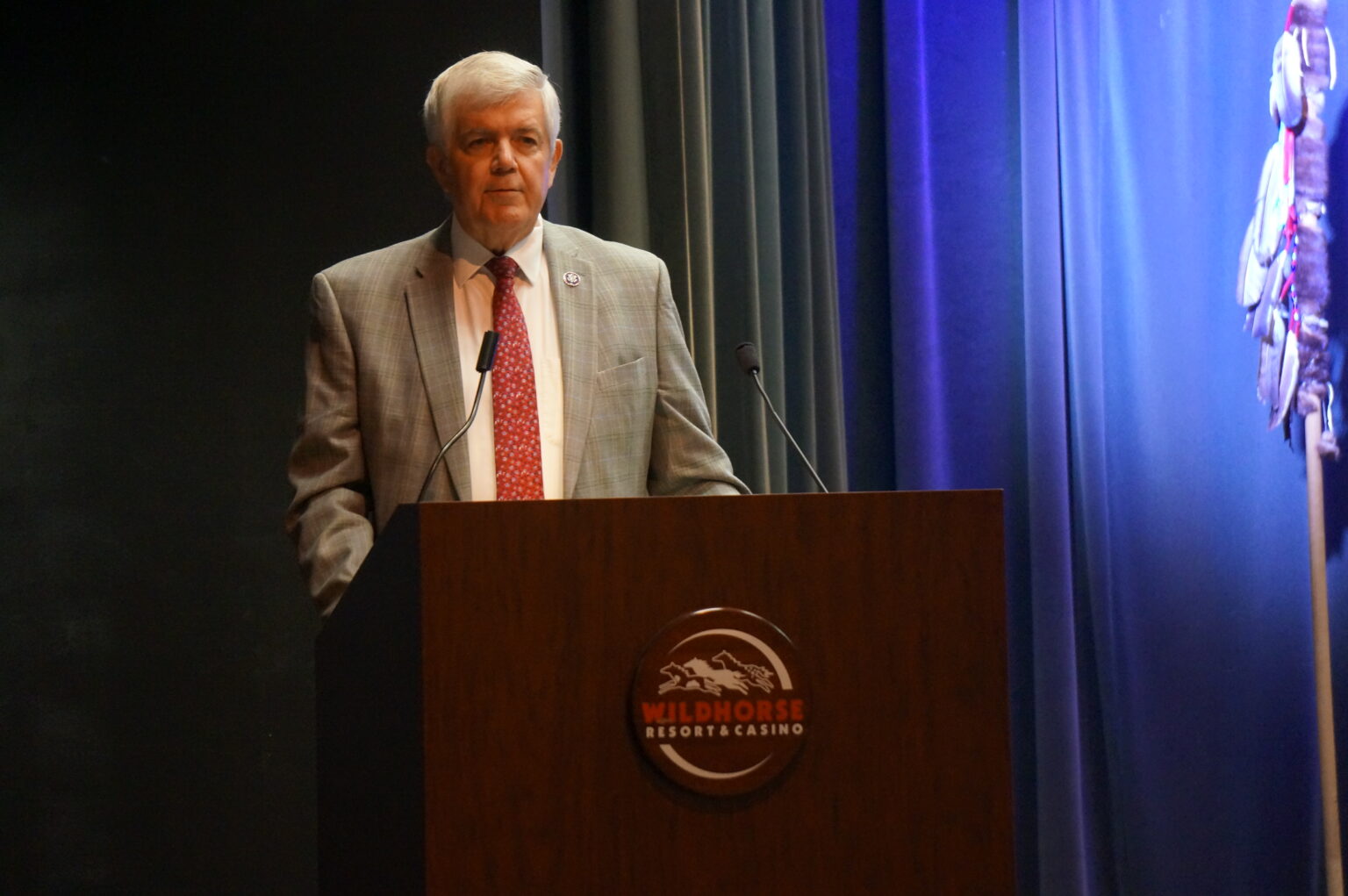Out and About: A tale of two trails in one: Maxwell Lake
Published 12:07 pm Tuesday, October 1, 2024

- A steep section of the Maxwell Lake Trail in the Eagle Cap Wilderness.
I tried to forget the trail to Maxwell Lake but my calf muscles kept reminding me.
Trending
They were quite insistent, as sore muscles tend to be.
With each halting step, in the few days after my wife, Lisa, and I climbed to the beautiful alpine lake in the Eagle Cap Wilderness, my calves relived the punishment I had inflicted on them.
Even when I adopted the clumsy gait seen most often in movies featuring zombies, the muscles protested each shambling stride.
Trending
I fancied at times that their agony was audible, rather like door hinges which have gone too long without oil.
Even absent the twinges from my lower legs, though, Maxwell Lake is a memorable place.
The trip to the lake, which lies in the granitic notch that a glacier gouged in the west wall of the Lostine River Canyon, is a sort of CliffsNote to the Eagle Cap Wilderness.
Every attribute that distinguishes the wilderness, Oregon’s largest at 360,000 acres, is compressed into this corner of the Wallowa Mountains.
Serrated peaks crowd the sky.
A crystalline stream, so cold that it numbs fingers and toes in a few seconds, chuckles its way through a forest that boasts most of the region’s coniferous species.
And a few of its deciduous ones.
There is a wildflower meadow, colorful even as autumn takes over for summer, that briefest season in the high country.
Views of distant peaks, including the distinctive shape of Eagle Cap itself, the namesake summit for the wilderness, which from this angle reminds me of Half Dome in Yosemite.
And there is the lake, the prize that culminates so many paths in the Wallowas.
Maxwell Lake, one of dozens in the Eagle Cap, could serve as the archetype.
Its water varies from pale green in the shallows to the shade of blue that only a deep mountain pool can create.
The lake is hemmed in on the south by a precipitous wall of stone, but the north and east shores are much gentler, with granitic boulders strewn about in a way that would make a landscape architect envious.
The flat spots, though few, seem perfectly designed to accommodate a backpacking tent.
(Campfires, however, are prohibited within a quarter mile of Maxwell Lake, a restriction that applies to several other lakes in the Eagle Cap. The fire ban preserves dead wood that serves as wildlife habitat and soil fertilizer, and prevents scars from flames.)
A rare day hike in the Wallowas
The Eagle Cap, if it could be said to have a flaw, is too big.
Many of its enchanting lakes lie so far from the trailhead — often 7 miles or more — that for most visitors (and their calf muscles) an overnight backpacking trip is the only feasible option.
Maxwell Lake is an exception.
The trail is about 4 miles long — no casual stroll, to be sure, but short enough that moderately fit hikers can cover the 8-mile round trip without having to lug a tent and backpack.
A burden you will be happy to eschew.
The trail, like the lake, seems to me a microcosm of mountains paths in the Eagle Cap and elsewhere.
In common with many trails in the Wallowas, this one tames the terrain by ascending the steep canyon wall in a series of traverses linked by switchbacks, the sharp turns where the trail reverses direction.
I appreciate the elegance of this design.
A well-constructed switchback, with its stacks of stones to delineate the route, pleases me in the way that a mountain highway, such as the Going to the Sun Road in Glacier National Park, does.
They lie lightly on the land, examples of humans adapting to topography rather than obliterating it.
I doubt anyone is so devoted to tedium as to have tallied the switchbacks among the more than 500 miles of trails in the Eagle Cap.
But I’m certain there are thousands.
The switchback style of trail that dominates in the wilderness is a testament to the popularity of using horses, both for riding and as beasts of burden.
I relish the variety of vistas on such trails.
The path to Maxwell Lake has seven switchbacks in the first 3 miles. The view alternates between looking north, down the canyon, and south, up the Lostine toward Eagle Cap.
The Maxwell Lake trail, by virtue of the switchbacks, climbs for those 3 miles at a gentle grade, gaining about 1,400 feet of elevation.
But not the gentlest grade in the Eagle Cap.
I reserve that accolade for the Frances Lake Trail, which ascends the east wall of the Lostine River Canyon and starts a few miles down the canyon from the Maxwell Lake trailhead. The Frances Lake Trail, although it gains more than 3,000 feet, distributes that considerable elevation over more than 25 switchbacks.
The Maxwell Lake Trail is similarly benign.
Until it is not.
This transition from a pleasant path to a malevolent slog is stark and sudden — the trail design version of being ambushed by a well-concealed predator.
At the seventh switchback the trail, rather than continuing on its meandering and modest way up the mountain, attacks the terrain with all the subtlety of a sledgehammer blow.
For almost a mile the path climbs straight up, with an occasional unimportant wiggle, toward the lake.
The trail gains almost 1,000 feet elevation in this section, a grade more than twice as steep as the lower portion.
And as my calves can attest, it feels considerably steeper than that.
Nor is that the extent of the trail’s treachery.
About a third of the way along this tortuous interlude, the trail briefly levels in a meadow.
This is the geographic feature that hikers, and climbers, dread.
The false summit.
I was skeptical, when the trail flattened, that Maxwell Lake was just ahead. We hadn’t been toiling up the steep stretch for anything close to a full mile, it seemed to me.
But I couldn’t suppress the hope that we had.
It was not to be.
At the meadow’s edge the trail resumed its punishing ascent.
If anything it was even steeper as it alternated between thickets of subalpine fir and open slopes carpeted with alpine fleeceflower.
The trail reaches a pass with the first view of the lake. The path then descends for a couple tenths of a mile to the lake’s northeast corner, near the tiny island 50 feet or so offshore.
Lisa and I made the trip on Sept. 28, what was likely the last hot day in a year noteworthy for its persistent heat.
At times during the climb, and especially the final mile, the sunlight seemed to me as potent as during July or August.
But the breeze that ruffled the lake and moaned through the subalpine firs and whitebark pines refreshed as only an alpine wind can.
The waning of summer was obvious even without the cool gusts, though.
The trailside huckleberry and snowberry bushes had in many places turned scarlet, and we also passed a few vine maples that shimmered yellow in the sunshine.
We spent close to an hour at the lake, snacking on beef jerky and crackers and the miraculous cheese product that is dispensed from a can, much like whipped cream except orange.
I soaked my feet in the chilly water.
I should have dunked my calves too.
From Lostine, on Highway 82 between Wallowa and Enterprise, drive south on the paved Lostine River Road. Continue on the road, which turns to graded gravel and, at the Lostine Guard Station, to rougher gravel, for about 18 miles to the Maxwell Lake Trailhead. It’s on the left (east) side of the road, opposite Shady Campground, which has several nice spots near the Lostine River.
A recreation pass, which costs $5 per day, is required at the trailhead.
The trail starts at the northwest corner of the campground, near a wooden bridge over the river. You can fill out a free Eagle Cap Wilderness permit, which is required for all visitors, including day hikers, at the signboard near the bridge.
The Lostine River Road is one of the more popular access points for the Eagle Cap Wilderness. The road passes several campgrounds and picnic areas, as well as the trailhead for Frances Lake and Bowman. The latter trail, like the Maxwell Lake Trail, climbs the west side of the canyon and leads to many lakes, including Chimney, Hobo, Woods and John Henry, to North Minam Meadows as well as connecting to multiple trails.
The Lostine River Road ends at Two Pan, a trailhead and campground. Two of the Eagle Cap’s more popular trails start here, one following the east fork of the Lostine to the Lake Basin and Eagle Cap, the other climbing along the west fork to Minam Lake.









